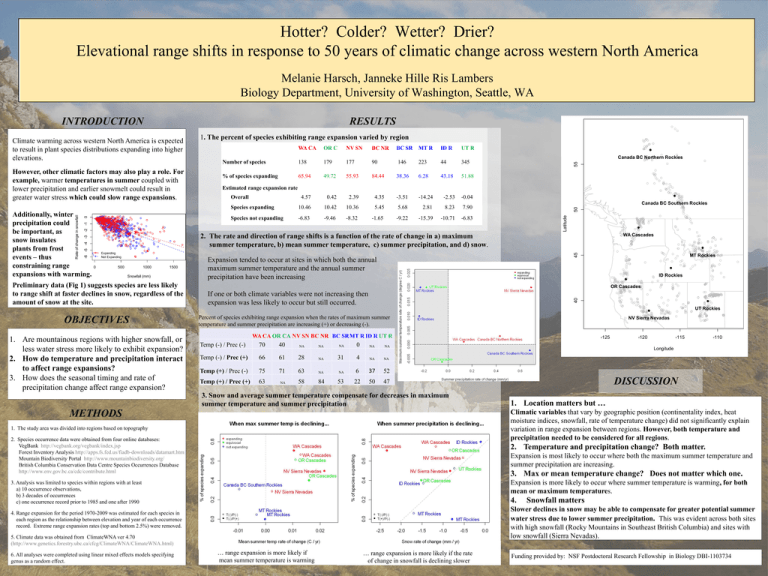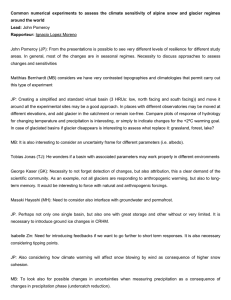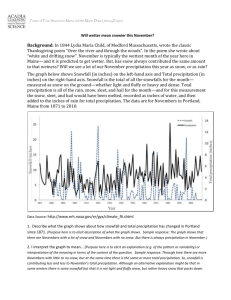Hotter? Colder? Wetter? Drier?
advertisement

Hotter? Colder? Wetter? Drier? Elevational range shifts in response to 50 years of climatic change across western North America Melanie Harsch, Janneke Hille Ris Lambers Biology Department, University of Washington, Seattle, WA INTRODUCTION RESULTS 0 BC NR BC SR MT R ID R UT R Number of species 138 179 177 90 146 223 44 345 % of species expanding 65.94 49.72 55.93 84.44 38.36 6.28 43.18 51.88 4.57 0.42 2.39 4.35 -3.51 -14.24 Canada BC Northern Rockies 55 NV SN Estimated range expansion rate Overall -2.53 -0.04 Species expanding 10.46 10.42 10.36 5.45 5.68 2.81 8.23 7.90 Species not expanding -6.83 -9.46 -8.32 -1.65 -9.22 -15.39 -10.71 -6.83 Canada BC Southern Rockies 2. The rate and direction of range shifts is a function of the rate of change in a) maximum summer temperature, b) mean summer temperature, c) summer precipitation, and d) snow. 500 1000 1500 Snowfall (mm) Preliminary data (Fig 1) suggests species are less likely to range shift at faster declines in snow, regardless of the amount of snow at the site. 45 Expanding Not Expanding WA Cascades Expansion tended to occur at sites in which both the annual maximum summer temperature and the annual summer precipitation have been increasing MT Rockies ID Rockies OR Cascades If one or both climate variables were not increasing then expansion was less likely to occur but still occurred. 40 -6 -5 -4 -3 -2 -1 Rate of change in snowfall Additionally, winter precipitation could be important, as snow insulates plants from frost events – thus constraining range 0 expansions with warming. OR C 50 However, other climatic factors may also play a role. For example, warmer temperatures in summer coupled with lower precipitation and earlier snowmelt could result in greater water stress which could slow range expansions. WA CA Latitude Climate warming across western North America is expected to result in plant species distributions expanding into higher elevations. 1. The percent of species exhibiting range expansion varied by region UT Rockies OBJECTIVES 1. Are mountainous regions with higher snowfall, or less water stress more likely to exhibit expansion? 2. How do temperature and precipitation interact to affect range expansions? 3. How does the seasonal timing and rate of precipitation change affect range expansion? METHODS Percent of species exhibiting range expansion when the rates of maximum summer temperature and summer precipitation are increasing (+) or decreasing (-). WA CA OR CA NV SN BC NR BC SR MT R ID R UT R Temp (-) / Prec (-) 70 40 NA NA NA 0 NA NA Temp (-) / Prec (+) 66 61 28 NA 31 4 NA NA Temp (+) / Prec (-) 75 71 63 NA NA 6 37 52 Temp (+) / Prec (+) 63 NA 58 84 53 22 50 47 3. Snow and average summer temperature compensate for decreases in maximum summer temperature and summer precipitation -125 -120 -115 -110 Longitude DISCUSSION 1. Location matters but … Climatic variables that vary by geographic position (continentality index, heat moisture indices, snowfall, rate of temperature change) did not significantly explain variation in range expansion between regions. However, both temperature and precipitation needed to be considered for all regions. 1. The study area was divided into regions based on topography 2. Species occurrence data were obtained from four online databases: VegBank http://vegbank.org/vegbank/index.jsp Forest Inventory Analysis http://apps.fs.fed.us/fiadb-downloads/datamart.html Mountain Biodiversity Portal http://www.mountainbiodiversity.org/ British Columbia Conservation Data Centre Species Occurrences Database http://www.env.gov.bc.ca/cdc/contribute.html 2. Temperature and precipitation change? Both matter. Expansion is most likely to occur where both the maximum summer temperature and summer precipitation are increasing. 3. Max or mean temperature change? Does not matter which one. Expansion is more likely to occur where summer temperature is warming, for both mean or maximum temperatures. 3. Analysis was limited to species within regions with at least a) 10 occurrence observations, b) 3 decades of occurrences c) one occurrence record prior to 1985 and one after 1990 4. Snowfall matters Slower declines in snow may be able to compensate for greater potential summer water stress due to lower summer precipitation. This was evident across both sites with high snowfall (Rocky Mountains in Southeast British Columbia) and sites with low snowfall (Sierra Nevadas). 4. Range expansion for the period 1970-2009 was estimated for each species in each region as the relationship between elevation and year of each occurrence record. Extreme range expansion rates (top and bottom 2.5%) were removed. 5. Climate data was obtained from ClimateWNA ver 4.70 (http://www.genetics.forestry.ubc.ca/cfcg/ClimateWNA/ClimateWNA.html) 6. All analyses were completed using linear mixed effects models specifying genus as a random effect. NV Sierra Nevadas … range expansion is more likely if mean summer temperature is warming … range expansion is more likely if the rate of change in snowfall is declining slower Funding provided by: NSF Postdoctoral Research Fellowship in Biology DBI-1103734





